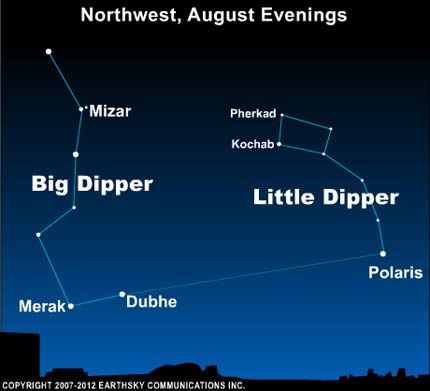Courtesy of EarthSky
A Clear Voice for Science
www.EarthSky.org
 The two outer stars in the bowl of the Big Dipper – Dubhe and Merak – always point to Polaris, the North Star. To find this Dipper at this time of year, look toward the northwest in the evening.
The two outer stars in the bowl of the Big Dipper – Dubhe and Merak – always point to Polaris, the North Star. To find this Dipper at this time of year, look toward the northwest in the evening.
Once you have found it – after locating Polaris – look more carefully at the second star from the end of the Big Dipper’s handle. If your sky is dark enough, and your eyesight is good, you will see that this star, Mizar, has a nearby companion, called Alcor.
Arabian stargazers called Mizar and Alcor the “horse and rider.” These stars are a good test of the night’s viewing conditions: if you cannot see Alcor, there might be thin clouds up there.
These two stars are what are called “naked-eye double star,” appearing double from our earthly vantage point. But do they orbit each other? Astronomers aren’t sure. The distances to these stars (as to most stars) are not precisely known. If Mizar and Alcor make up a true binary star, it is a very wide one. If they do lie at the same distance from Earth, their separation is .27 light-years . . . that’s in contrast to eight light-minutes for Earth’s distance from our sun . . . or several light-hours for the distance to our sun of the most distant worlds in our solar system. Still, it is possible that Mizar and Alcor could be this far apart and still be orbiting one another, with a very long orbital period of three-quarters of a million years.
Written by Deborah Byrd
Astronomy Picture of the Day from NASA/JPL
U.S. Naval Observator Astronomical Information center